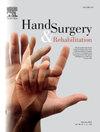Morphometric and curvature CT-based study of the distal radius watershed line
IF 1
4区 医学
Q4 ORTHOPEDICS
引用次数: 0
Abstract
Purpose
Fixation of distal radius fractures involving the volar rim is technically demanding and often complex. In most cases, it requires the use of so-called “specific” plates. Although these plates have been developed using morphometric databases, proper application can still be imperfect—even when the plate appears to be correctly positioned. This mismatch may result in secondary displacement of the fragment, tendon irritation, or even tendon rupture. We hypothesized that anatomical variations in the radius, particularly in the shape of the watershed line, may explain the difficulty in achieving optimal plate adaptation in some patients.
Methods
Nineteen distal radius were analyzed using Computed Tomography-scan segmentation and curvature analysis to assess the shape of the watershed line. K-means clustering was then performed to identify distinct groups based on volar rim curvature patterns.
Results
Clustering analysis revealed two distinct anatomical groups based on volar rim curvature. The first group exhibited a mean curvature of 0.07 ± 0.03 mm−¹, while the second group had a significantly higher curvature of 0.23 ± 0.06 mm−¹ (mean ± SD). A Student’s t-test confirmed a statistically significant difference between the two groups (p < 0.001).
Conclusions
Our findings suggest the existence of at least two anatomical variations in volar rim shape at the watershed line, forming a spectrum between flatter and more sharply curved forms. These anatomical differences may explain inconsistencies in plate adaptation and should be taken into account by surgeons when selecting and positioning fixation hardware.
Level of evidence
Diagnostic study (IIIb).
基于形态学和曲率ct的远端半径分水岭线研究。
目的:桡骨远端掌侧缘骨折的固定技术要求高且复杂。在大多数情况下,它需要使用所谓的“特定”板。尽管这些板是使用形态测量数据库开发的,但正确的应用仍然可能是不完美的——即使板看起来是正确定位的。这种不匹配可能导致碎片的继发性移位,肌腱刺激,甚至肌腱断裂。我们假设,桡骨的解剖变异,特别是分水岭线的形状,可能解释了一些患者难以实现最佳钢板适应。方法:采用计算机断层扫描分割和曲率分析对19个远端半径进行分析,以评估分水岭线的形状。然后进行K-means聚类,以识别基于掌侧边缘曲率模式的不同组。结果:聚类分析显示掌侧缘曲率为两个不同的解剖类群。第一组的平均曲率为0.07±0.03 mm-¹,而第二组的曲率为0.23±0.06 mm-¹(mean±SD)。学生t检验证实了两组之间的统计学差异(p)。结论:我们的研究结果表明,在分水岭线上,至少存在两种掌侧边缘形状的解剖学差异,形成了更平坦和更陡峭弯曲形式之间的光谱。这些解剖上的差异可能解释了钢板适应的不一致,外科医生在选择和定位固定物时应考虑到这一点。证据等级:诊断性研究(IIIb)。
本文章由计算机程序翻译,如有差异,请以英文原文为准。
求助全文
约1分钟内获得全文
求助全文
来源期刊

Hand Surgery & Rehabilitation
Medicine-Surgery
CiteScore
1.70
自引率
27.30%
发文量
0
审稿时长
49 days
期刊介绍:
As the official publication of the French, Belgian and Swiss Societies for Surgery of the Hand, as well as of the French Society of Rehabilitation of the Hand & Upper Limb, ''Hand Surgery and Rehabilitation'' - formerly named "Chirurgie de la Main" - publishes original articles, literature reviews, technical notes, and clinical cases. It is indexed in the main international databases (including Medline). Initially a platform for French-speaking hand surgeons, the journal will now publish its articles in English to disseminate its author''s scientific findings more widely. The journal also includes a biannual supplement in French, the monograph of the French Society for Surgery of the Hand, where comprehensive reviews in the fields of hand, peripheral nerve and upper limb surgery are presented.
Organe officiel de la Société française de chirurgie de la main, de la Société française de Rééducation de la main (SFRM-GEMMSOR), de la Société suisse de chirurgie de la main et du Belgian Hand Group, indexée dans les grandes bases de données internationales (Medline, Embase, Pascal, Scopus), Hand Surgery and Rehabilitation - anciennement titrée Chirurgie de la main - publie des articles originaux, des revues de la littérature, des notes techniques, des cas clinique. Initialement plateforme d''expression francophone de la spécialité, la revue s''oriente désormais vers l''anglais pour devenir une référence scientifique et de formation de la spécialité en France et en Europe. Avec 6 publications en anglais par an, la revue comprend également un supplément biannuel, la monographie du GEM, où sont présentées en français, des mises au point complètes dans les domaines de la chirurgie de la main, des nerfs périphériques et du membre supérieur.
 求助内容:
求助内容: 应助结果提醒方式:
应助结果提醒方式:


